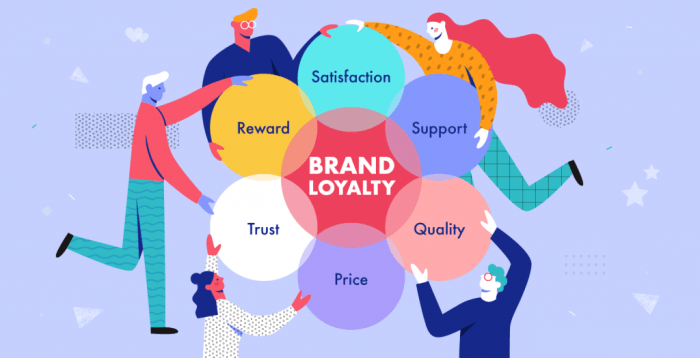Building a Brand Loyalty Program delves into the world of creating lasting connections with customers through innovative strategies and personalized experiences. From defining loyalty programs to implementing them successfully, this topic explores the ins and outs of fostering brand loyalty.
Introduction to Brand Loyalty Programs: Building A Brand Loyalty Program

A brand loyalty program is a marketing strategy designed to encourage customers to continue purchasing products or services from a specific brand. These programs often reward customers for their repeat business, leading to increased customer retention and brand loyalty.
Importance of Brand Loyalty for Businesses
Brand loyalty is crucial for businesses as it helps in creating a strong customer base, increasing customer lifetime value, and fostering brand advocacy. Loyal customers are more likely to recommend the brand to others, resulting in organic growth and reduced marketing costs.
Examples of Successful Brand Loyalty Programs
- Starbucks Rewards: Starbucks offers a loyalty program where customers earn points for every purchase, leading to free drinks and other perks.
- Amazon Prime: Amazon’s subscription-based loyalty program provides members with fast shipping, exclusive deals, and access to streaming services.
- Sephora Beauty Insider: Sephora’s loyalty program offers members exclusive discounts, birthday gifts, and early access to new products.
Designing a Brand Loyalty Program
When designing a brand loyalty program, there are several key components to consider in order to create a successful and engaging program for your customers. It’s important to think about the goals of the program, the target audience, the rewards offered, and the overall customer experience.
Types of Brand Loyalty Programs
- Points-Based Programs: Customers earn points for each purchase, which can be redeemed for rewards or discounts.
- Tiered Programs: Customers move up different levels or tiers based on their loyalty, unlocking more benefits as they progress.
- Paid Programs: Customers pay a fee to join a loyalty program, gaining access to exclusive perks and rewards.
It’s essential to choose a type of program that aligns with your brand values and resonates with your target audience.
Tips for Creating a Successful Program
- Understand Your Customers: Take the time to research and understand what motivates your customers and tailor the program to their preferences.
- Offer Valuable Rewards: Make sure the rewards you offer are attractive and valuable to your customers to keep them engaged.
- Communicate Effectively: Keep your customers informed about the program, rewards, and their progress to maintain engagement.
- Create a Seamless Experience: Ensure that the program is easy to use and navigate, providing a seamless experience for your customers.
Benefits of Brand Loyalty Programs
Brand loyalty programs offer a range of advantages for both customers and businesses. These programs are designed to reward customers for their repeat business, ultimately fostering a sense of loyalty and connection to the brand. Let’s dive into the key benefits of implementing a brand loyalty program.
Enhanced Customer Retention
- Brand loyalty programs have been shown to increase customer retention rates significantly. According to a study by Bond Brand Loyalty, members of loyalty programs are 70% more likely to continue doing business with a company.
- By offering rewards and incentives to loyal customers, businesses can create a strong emotional bond that keeps customers coming back for more.
- Increased customer retention leads to higher lifetime value for each customer, contributing to long-term business success.
Boosted Revenue
- Implementing a brand loyalty program can have a direct impact on revenue generation. Research by Harvard Business Review found that increasing customer retention rates by just 5% can boost profits by 25% to 95%.
- Loyal customers tend to spend more and make more frequent purchases, driving up sales and revenue for the business.
- Through targeted marketing efforts within the loyalty program, businesses can encourage customers to spend more to unlock rewards, further increasing revenue.
Enhanced Customer Engagement and Satisfaction
- Brand loyalty programs create opportunities for businesses to engage with customers on a deeper level, fostering a sense of community and belonging.
- By offering personalized rewards and experiences, businesses can enhance customer satisfaction and build stronger relationships with their loyal customer base.
- Engaged customers are more likely to provide valuable feedback and referrals, contributing to the overall growth and success of the business.
Implementing a Brand Loyalty Program
Implementing a brand loyalty program involves several key steps that are essential for its success. Businesses need to carefully plan and execute each phase to ensure maximum customer engagement and retention.
Steps in Implementing a Brand Loyalty Program
- 1. Define objectives and goals: Clearly Artikel what the loyalty program aims to achieve and how it aligns with the overall business strategy.
- 2. Choose the right rewards structure: Decide on the type of rewards, such as discounts, exclusive offers, or points-based systems, that will incentivize customers to participate.
- 3. Select a loyalty program platform: Invest in a reliable platform that can effectively manage customer data, track rewards, and provide insights for program improvement.
- 4. Communicate the program to customers: Create a marketing strategy to inform customers about the benefits of the loyalty program and how they can participate.
- 5. Monitor and analyze performance: Regularly evaluate key performance indicators to measure the success of the program and identify areas for improvement.
Challenges in Implementing a Brand Loyalty Program, Building a Brand Loyalty Program
- – Limited customer engagement: Some customers may be hesitant to join the program or may not fully understand the benefits.
- – Data security concerns: Managing customer data securely and in compliance with regulations can be a challenge for businesses.
- – Competition: Standing out in a crowded market with various loyalty programs can make it difficult to attract and retain customers.
Best Practices for a Successful Rollout of a Loyalty Program
- 1. Start with a pilot program: Test the loyalty program with a small group of customers to gather feedback and make necessary adjustments before a full rollout.
- 2. Personalize the experience: Tailor rewards and communications to individual customer preferences to enhance engagement and loyalty.
- 3. Offer exclusive benefits: Provide unique rewards or perks that are only available to loyalty program members to increase their sense of value.
- 4. Continuously optimize the program: Regularly review performance metrics and customer feedback to make improvements and keep the program relevant.
Measuring the Success of a Brand Loyalty Program
To determine the effectiveness of a brand loyalty program, it is crucial to track key metrics that provide insights into customer engagement, retention, and overall program performance.
Key Metrics to Track
- Customer Retention Rate: Measure the percentage of customers who continue to make repeat purchases or engage with the brand over a specified period.
- Customer Lifetime Value (CLV): Calculate the total revenue generated from a customer throughout their relationship with the brand, helping to assess the long-term profitability.
- Redemption Rate: Monitor how many loyalty rewards or offers are redeemed by customers, indicating the program’s attractiveness.
Collecting and Analyzing Data
Utilize customer data collected through loyalty program registrations, purchase history, and feedback surveys to evaluate the program’s effectiveness. Analyze this data regularly to identify trends, preferences, and areas for improvement.
Using Customer Feedback
Customer feedback is a valuable source of information for enhancing a brand loyalty program. Listen to customer suggestions, complaints, and preferences to make informed decisions about program adjustments and enhancements.
Enhancing Brand Loyalty through Personalization

Personalization plays a crucial role in strengthening brand loyalty by creating a more personalized and engaging experience for customers. By tailoring interactions, products, and services to individual preferences, brands can build stronger emotional connections with their customers, leading to increased loyalty and repeat business.
Role of Personalization in Strengthening Brand Loyalty
Personalization allows brands to show customers that they are valued and understood, leading to a sense of exclusivity and special treatment. By customizing communication, recommendations, and rewards based on customer behavior and preferences, brands can make each interaction feel unique and tailored to the individual.
- Personalized product recommendations based on past purchases or browsing history can increase customer satisfaction and drive repeat purchases.
- Customized loyalty rewards and offers targeted to specific customer segments can incentivize loyalty program participation and engagement.
- Personalized communication through targeted emails, messages, or notifications can enhance customer engagement and build brand affinity.
Examples of Personalized Experiences Impacting Customer Loyalty
- Amazon’s personalized product recommendations based on browsing history and purchase behavior have significantly increased customer retention and loyalty.
- Starbucks’ personalized rewards and offers through their mobile app have led to higher customer engagement and increased visits to their stores.
- Netflix’s personalized content recommendations based on viewing history have improved customer satisfaction and retention rates.
Strategies for Leveraging Data to Personalize Interactions within a Loyalty Program
- Collect and analyze customer data to understand preferences, behaviors, and purchase history.
- Segment customers based on common traits or behaviors to deliver targeted and personalized experiences.
- Use technology such as AI and machine learning to automate and personalize interactions at scale.
- Solicit feedback from customers to continually improve and refine personalized experiences within the loyalty program.





